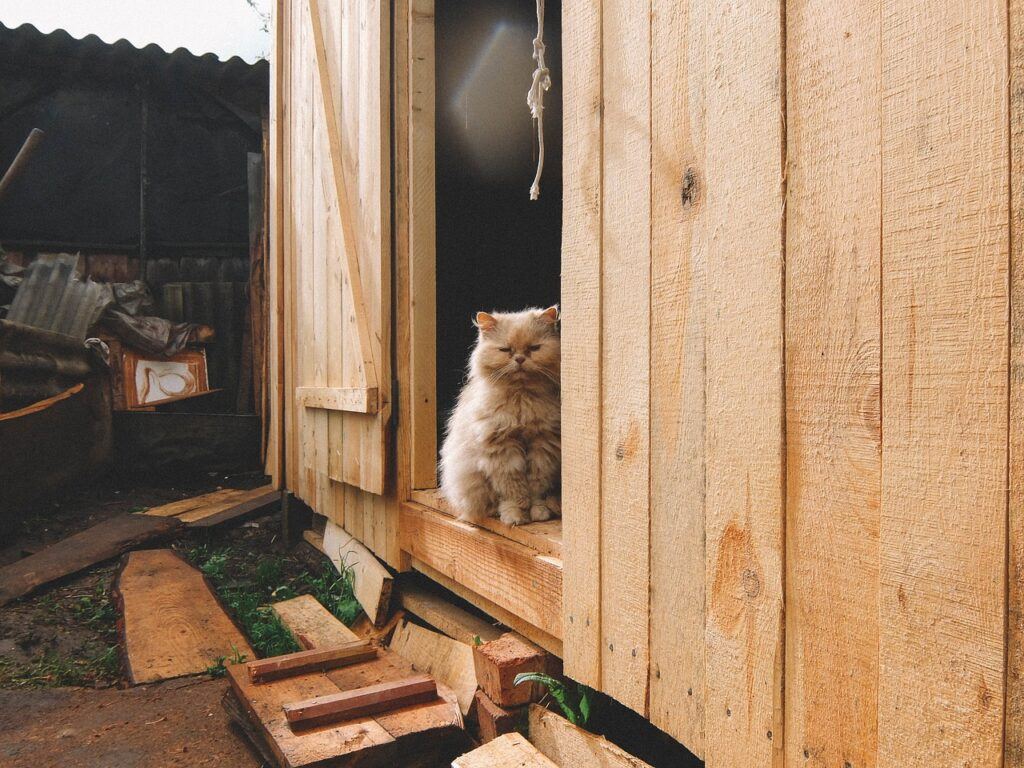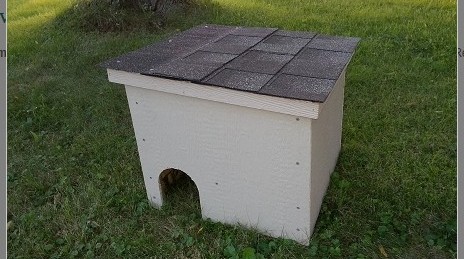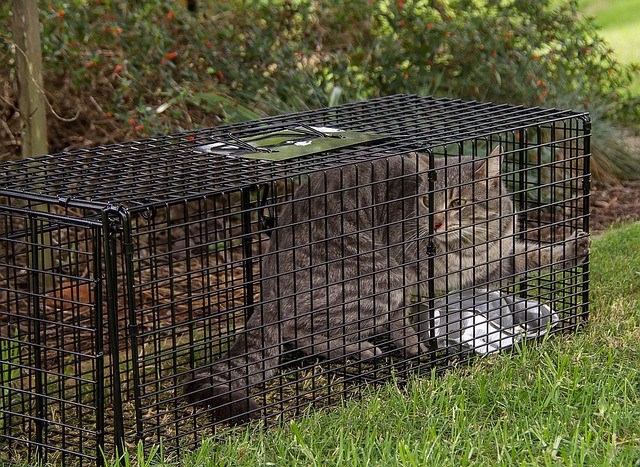
Cat caretakers are always trying to figure out how to keep outdoor cats safe. Because let’s face it. Cats who live or go outside are never 100% safe.
Never.
Whether you live in town or on a farm, cats with outside access have a lower average lifespan than indoor-only cats do.
But some cats can’t or won’t live indoors with humans. So what do you do? You learn how to keep outdoor cats safe! Or rather safer.
Disclaimer: This post contains affiliate links. I may earn a small commission from qualifying purchases, at no cost to you. Read the Affiliate Disclosure for full details.
Trap-Neuter-Return Your Colony
GASP! Did you know that fixing the cats you feed outdoors actually HELPS to keep them safe?! It does!
Cats who have their reproductive organs have reproductive instincts and urges. There are quite a few urges that can make living outside even MORE dangerous.
Which behaviors are riskier?
- Cats roam – often for MILES – looking for potential mates. It’s a compulsion that can lead them to cross a lot of busy roads, roam off into the wilderness, or venture into dangerous environments.
- Intact male cats fight. They fight a lot and they fight viciously. Cat bites or scratches get infected easily, which could cause severe infection, sepsis, and abscesses. All of which could be fatal if left untreated.
- Intact cats, especially the males, are the most likely cats to be infected with Feline Leukemia Virus or Feline Immunedeficiency Virus. Both of these viruses are deadly. Both of these viruses are spread mainly by deep bite wounds and mating. Biting and mating most often occur between unfixed cats in the colony. And the intact males will be spreading it to the other cats in the colony.
- 75% of kittens don’t survive to reach 6 months old. Kittens die. They’re fragile, tiny, and easily killed. And most kittens born outside WILL die.
All of these behaviors are greatly reduced or eliminated when colonies are fixed. There’s even been a study done on how TNR affects preventable deaths!
Microchip Your Cats
I cannot stress this enough. Please, please, PLEASE microchip all cats that you get fixed. This will help prevent them from being euthanized as an unwanted feral cat at the shelter.
Microchips will help your outdoor cats if they are ever found. Nothing worse than knowing someone had found the cat you’ve been missing for two months, but because they weren’t chipped, you never got a call and it’s too late now.
This will also protect the cats from people who randomly trap free-roaming cats to dump at the shelter. At least the shelter will call you when it happens.
Confine Cats Inside at Night
No, I don’t mean in your house. Though that is possible if you want to, of course.
Most predation of cats occurs in the evening and night. That’s because most wild animals avoid humans and humans aren’t as abundant outside at night, so that’s when these animals will prowl around your house or property!
Animals that can kill cats include, but are not limited to, the following:
- Coyotes
- Raccoons
- Birds of prey, such as hawks, eagles, and owls.
- Mountain lions
- Wolves
- Bobcats
- Opossums
- Snakes
- Dogs
Many of these predators often are crepuscular or nocturnal. Crepuscular animals are most active around dusk and dawn. This includes our beloved cats! Cats are actually not nocturnal. They’re crepuscular.
By preventing the cats from roaming around in the evening and night, you help reduce their chances of having a confrontation with other animals!
If you feed very large colonies of cats, this is not really going to be much of an option for you. It IS an option for barn cats, though!

How to get feral cats to come in at night
You can do this by feeding your colony on a set schedule of at least two times a day. Once in the morning and once at night. Feeding schedules are important for reasons I’ll mention later. Make sure to include the wet food at the nighttime feeding, even if you cannot feed wet food at morning feeding.
You can use the wet food to entice your cat colony to come into your building of choice, whether it’s your garage or barn tack room or large pottery shed.
Lock them in there with comfy blankets, cat beds, boxes, and appropriate bathroom facilities (i.e. litter boxes).
Collars are a Maybe!
If you’re concerned someone is going to try to steal or harm the cat, collars might be a good idea. As long as they are breakaway collars designed for cats. This could be useful if you have neighbors near enough to confuse your barn cats for a new stray showing up. People are also more likely to look for an owner if a cat is collared when they find the cat.
Breakaway collars are designed to break apart if it ever gets hung up on a tree branch or something so that the cat can escape. Instead of strangling themselves.
But if that is not a concern for you, I would not collar any outdoor cats.
High Spaces are a Cat’s Escape Route

You WANT your cats to have access to shelves, tall hay bales, trees, or ledges so they can leap up off the ground to get away from most ground predators. Make sure to plan their environment appropriately!
One idea to help cats have high hiding spots is to buy cat shelves or make your own shelves or steps with wood!
But no matter what you choose to do to the area, whether it’s simple wooden steps built into a barn wall the cats can jump onto or shelves along the inside and outside areas, hay bale stacks, or whatever, let the cats have access to places high off the ground.
Catios and Cat Fences
Many cat caretakers with yards will choose to build or buy elaborate catios for their ferals! If you only have a few cats living in your yard, this is a great alternative to letting them run loose.
It’s also an excellent idea for people who feel badly for keeping their cats indoors but don’t want them to die horribly roaming-free.
Other ways to keep your outdoor cats safe can include modifying the fence around your yard so that cats can’t get out! Or build a cat fence around your entire yard.
Electric fences are also another solution but usually require a collar. They don’t shock your cat, they give off a vibration to keep the cat contained.

Cat Shelters and Cat Houses
Cat shelters and cat houses can help provide small hiding spots for cats to sleep safely away from extreme weather and temperatures. Especially in winter!
You can purchase these or make your own!
Related Post: 9 Best Outdoor Cat Shelters for Winter

Cat Doors
Cat doors will help give your barn cats or feral cats access to indoor safety! Cat doors can come with flaps or without. Some can be locked. And some will only open for certain microchips!
Cat doors can be installed in windows, tack room doors, garage doors, and even through walls!
GPS Trackers
Cat GPS trackers will require that you have the cat collared with a specific type of transmitter. It CAN be bulky, so fair warning.
How GPS trackers work is by having a device attached to your pet. You then use a phone app to track where your cat or dog currently is. Some of them are VERY advanced. Some of them are pretty simple and use Bluetooth instead of GPS. Price has a lot to do with the specific capabilities of the tracker.
And all of them usually requires some sort of monthly subscription to keep the tracking active.
Cats who live outdoors should only wear breakaway collars, so be prepared to track down the GPS tracker regularly as well.
It might be an option for some of you! Definitely not for purely feral cats, but I know that some of you may wish to use these.

How to Keep Your Outdoor Cats Safe
Barn cats with a proper caretaker can live long, healthy lives. Feral cats in colonies properly managed can live to be nearly 20 years old as well.
There are other ways to ensure they’re happy, safe and healthy that include:
- regular meals two to three times a day, at least one of those meals should include wet cat food
- access to fresh water at all times
- basic veterinary care – like vaccinations, parasite treatments, and flea preventative – as well as emergency vet care for illness or injury
There is no reason to allow your outdoor cats to breed, even if you only keep them around to be mousers. Fixed cats are much better mousers than intact cats anyway. Proper care of them equals better pest control because they’ll be healthier and happier.
No one should choose to let their barn cats breed because they’re always dying. That means YOU are not taking care of them. It doesn’t take much to help them out with food, spay/neuter surgeries, and emergency care. They’re doing a great service for you and feeding them is not enough of a reward. They deserve decent care.
This goes for feeders too. Feeding cats is NOT enough. It causes more harm than if you had just left them alone. Become a proper caretaker and help keep your cats safe, healthy, and happy.
Do you have any other ideas on how to keep outdoor cats safe? Leave a comment and let me know!
Lovies!

